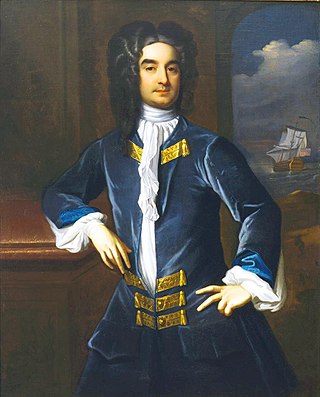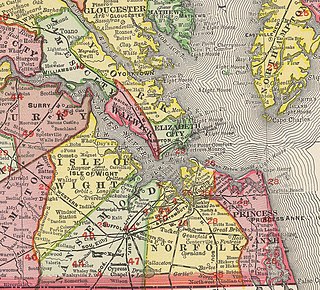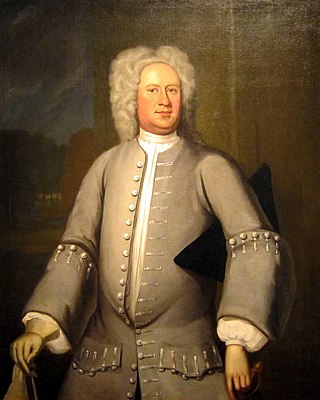
The Colony of Virginia, chartered in 1606 and settled in 1607, was the first enduring English colony in North America. It followed failed attempts at settlement on Newfoundland by Sir Humphrey Gilbert in 1583 and the Roanoke Colony by Sir Walter Raleigh in the late 1580s.

The Province of Maryland was an English and later British colony in North America that existed from 1632 until 1776, when it joined the other twelve of the Thirteen Colonies in rebellion against Great Britain and became the U.S. state of Maryland. Its first settlement and capital was St. Mary's City, in the southern end of St. Mary's County, which is a peninsula in the Chesapeake Bay and is also bordered by four tidal rivers.

William Byrd II was an American planter, lawyer, surveyor, author, and a man of letters. Born in Colonial Virginia, he was educated in London, where he practiced law. Upon his father's death, he returned to Virginia in 1705. He was a member of the Virginia Governor's Council from 1709 to 1744. He was the London agent for the House of Burgesses in the 1720s. Byrd's life showed aspects of both British colonial gentry and an emerging American identity.

Nansemond is an extinct jurisdiction that was located south of the James River in Virginia Colony and in the Commonwealth of Virginia in the United States, from 1646 until 1974. It was known as Nansemond County until 1972. From 1972 to 1974, a period of eighteen months, it was the independent city of Nansemond. It is now part of the independent city of Suffolk.

Isham Randolph was a planter, a merchant, a public official, and a shipmaster. He was the maternal grandfather of United States President Thomas Jefferson.

Robert "King" Carter was a merchant, planter and powerful politician in colonial Virginia. Born in Lancaster County, Carter eventually became one of the richest men in the Thirteen Colonies. As President of the Virginia Governor's Council, Carter served as the royal governor of Virginia from 1726 to 1727 after the previous governor, Hugh Drysdale, died in office. He acquired the moniker "King" from fellow Virginians in his lifetime connoting his wealth, autocratic business methods and political power. Carter also served as the colony's Treasurer, many terms in the House of Burgesses and twice fellow members elected him as their Speaker.
The James River Bateau was a shallow draft river craft used during the period from 1775 to 1840 to transport tobacco and other cargo on the James River and its tributaries in the Commonwealth of Virginia. It was flat bottomed and pointed at both ends. The length of the bateau varied greatly, 58 feet (18 m) being a common length. The bateau was propelled by bateaumen pushing with long sturdy poles. Alternate spellings of bateau include batteau, batoe and the plurals bateaux, batoes, and batteaux. Bateau is the French word for boat. In the colonial days, bateaus were used extensively in rivers throughout the eastern part of the United States, but the coverage of this article is confined to those that plied the James River in the Commonwealth of Virginia.

Sir William Gooch, 1st Baronet was a British Army officer and colonial administrator who served as the governor of Virginia from 1727 to 1749. Technically, Gooch only held the title of Royal Lieutenant Governor, but the nominal governors, Lord Orkney and Lord Albemarle, were in England and did not exercise much authority. Gooch's tenure as governor was characterized by his unusual political effectiveness.
Kempsville is a borough in the City of Virginia Beach, Virginia, a historic section with origins in US colonial times located in the former Princess Anne County. In modern times, it is a community within the urbanized portion of the independent city of Virginia Beach, the largest city in Virginia.

King William County is a county located in the U.S. state of Virginia. As of the 2020 census, the population was 17,810. Its county seat is King William.
Aylett is an unincorporated community in King William County, Virginia, United States. It is located where Virginia State Route 360 crosses the Mattaponi River. William Aylett and his family had several prominent warehouses and mills in the area.

Tobacco cultivation and exports formed an essential component of the American colonial economy. During the Civil War, they were distinct from other cash crops in terms of agricultural demands, trade, slave labor, and plantation culture. Many influential American revolutionaries, including Thomas Jefferson and George Washington, owned tobacco plantations, and were financially devastated by debt to British tobacco merchants shortly before the American Revolution.
The Wicocomico, Wiccocomoco, Wighcocomoco, or Wicomico were an Algonquian-speaking tribe who lived in Northumberland County, Virginia, at the head and slightly north of the Little Wicomico River. They were the first native people on the mainland encountered by Captain John Smith, prior to his famous interaction with Pamunkee and Pocahontas of the Powhatan people. Due to constant encroachment and manipulation by settlers, opportunists and Captain Smith, as well as internal conflict regarding how to respond to these, the tribe splintered. The colonial court of Virginia ordered them to merge with a smaller tribe and renamed the Wicocomico. They were assigned a flag -- and a reservation of 4,400 acres (18 km2) near Dividing Creek, south of the Great Wicomico River.

Pungoteague Creek is a creek in Accomack County, Virginia, United States. Pungoteague Creek Light and Pungoteague, Virginia are named after this creek.
The Burwells were among the First Families of Virginia in the Colony of Virginia. John Quincy Adams once described the Burwells as typical Virginia aristocrats of their period: forthright, bland, somewhat imperious and politically simplistic by Adams' standards. In 1713, so many Burwells had intermarried with the Virginia political elite that Governor Spotswood complained that " the greater part of the present Council are related to the Family of Burwells...there will be no less than seven so near related that they will go off the Bench whenever a Cause of the Burwells come to be tried."

The history of Alexandria, Virginia, begins with the first European settlement in 1695. Over the next century, the town became a significant port. In 1801, much of Alexandria was swept into the new District of Columbia; it was damaged along with much of the rest of the capital during the War of 1812. In 1846, Alexandria was returned to Virginia, along with the rest of the District's territory on the western side of the Potomac River. After Virginia seceded in 1861, Alexandria was swiftly captured by Union forces and held for the remainder of the American Civil War. In the late 20th century, Alexandria became a key part of the rapidly growing Northern Virginia region.

Hanover Town is a former colonial-era town in Hanover County, Virginia. It was located on the upper Pamunkey River on land originally granted to John Page in 1672. Before being called Hanover Town, the location was originally known as "Page's Warehouse." By the time of the 1730 Tobacco Inspection Act there was a tobacco warehouse at the site, referred to as "Crutchfield's" after the tobacco inspector John Crutchfield. The town was chartered in 1762. The town was raided by British forces during the American Revolutionary War, and its fortunes declined in the years after independence because of silting in the river, resulting in its eventual abandonment.
Totuskey Creek is a tributary of the Rappahannock River located in Richmond County, Virginia. The creek meets the river near Wellford, Virginia.

Powell's Creek is a tributary of the James River on the south side of the James River in Prince George County, Virginia, United States. The creek borders James River National Wildlife Refuge near Garysville, Virginia.
Colonel William Tayloe also known as William Teylow, was a British immigrant, colonist, and planter, from Gloucester, England, who emigrated to the British Colony of Virginia and resided in York County. His coat of arms, Vert a sword erect Or between two lions rampant addorsed Ermine, matches those of Teylow in Gloucester, England.













